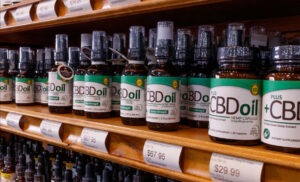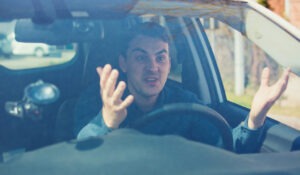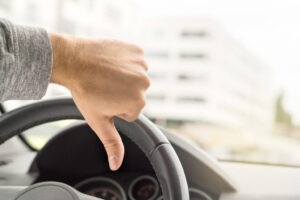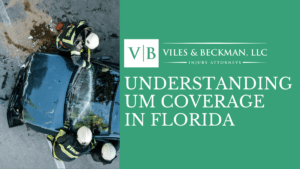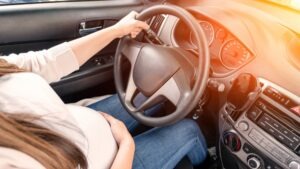
In a T-bone accident, the front of one car strikes the side of another, roughly forming a “T” shape at the moment of impact. T-bone accidents most commonly occur at intersections where lanes of traffic cross at right angles. A T-bone accident can cause serious injury for everyone in both vehicles, though passengers in the car hit on its side (especially those on the side impacted) face particularly extreme danger.
Auto accident lawyers for victims of T-bone accidents sometimes face a challenge in determining who bears liability for the injuries that their clients have suffered. Below, we discuss some of the considerations that go into sorting out who-is-liable-to-whom following a T-bone accident.
1. Driver Error
The typical T-bone accident involves a collision between two vehicles in the middle of an intersection. It is usually fair to assume that one of those two vehicles should not have been in the intersection at that moment; in other words, that at least one of the vehicles’ drivers made a potentially-catastrophic mistake. The question is, which driver? Some factors to consider include:
Did one driver run a red light or stop sign?
Many T-bone accidents occur because one driver failed to slow down or stop at a light or stop sign. With some investigation, police, insurance companies, and attorneys may locate evidence to help them determine which driver ignored a traffic signal. That driver will, typically (but not necessarily always), bear liability for the accident.
Did either driver speed or drive too fast for road conditions?
Driving too fast, even if below the speed limit, can make it difficult for a driver to stop in time to prevent an accident at an intersection. Even a driver with the right of way at an intersection can put others in danger by speeding, for instance, by making it difficult for a driver in a crossing lane to determine whether it is safe to enter the intersection ahead of crossing traffic. In fact, a driver’s risk of causing an accident can increase by 2 percent for every 1 percent increase in speed. So, by determining the speed of both vehicles in an accident, lawyers may pinpoint one of the drivers as the legally liable party.
Did driver distraction contribute to the accident?
Distracted drivers pose an extreme danger to themselves and others. At intersections, drivers who steal a peek at their phones to read posts or send texts tend to lose focus on traffic control signals, which increases the risk that they will enter an intersection against a red light or without checking for crossing traffic.
Device screens constitute just one of many potential distractions behind the wheel that can increase the risk of a T-bone crash. Other potentially-deadly distractions include:
- Talking on a cell phone, even via a Bluetooth device or on speakerphone
- Talking to other passengers in the vehicle
- Eating or drinking, especially messy foods
- Applying makeup
- Reaching for something that got away
- Changing the station on the radio
- Checking the GPS or inputting information into it
- Adjusting music or temperature in the vehicle
In fact, anything that takes a driver’s hands off the wheel, eyes off the road, or mind off the task of driving safely constitutes a dangerous distraction that can lead to a T-bone accident. Lawyers, and others investigating T-bone accidents, often look for evidence—such as cell phone records—to determine if someone’s distracted driving caused the crash, because that person may owe the victim legal liability.
Did drinking and driving contribute to the accident?
Impaired driving leads to far-too-many T-bone accidents every year in the Sunshine State. Driving under the influence of drugs or alcohol increases the risks of a T-bone crash by:
- Impairing decision-making about when it is safe to enter an intersection or to pull in front of crossing traffic
- Impairing vision, increasing the likelihood that the driver will fail to see other vehicles
- Reducing reaction time, which raises the risk of a driver not stopping at a red light or stop sign in time to avoid a T-bone collision
- Promoting reckless driving, such as speeding through an intersection
A driver in a T-bone crash who operated his or her vehicle under the influence of drugs or alcohol will likely face legal liability for causing the accident (not to mention also face potential criminal liability).
Expect More, Receive More: Legal Support That Feels Like Family
2. Mechanical Failure
Most drivers apply their brakes as they approach intersections, particularly one with a red light or a stop sign. Drivers expect their brakes to catch and hold their vehicles, preventing them from careening into intersections. When their brakes fail, those drivers lose control and may have no ability to avoid a T-bone collision.
Failing brakes constitute just one of a variety of mechanical breakdowns that can lead to a deadly T-bone crash by impairing a driver’s control of a vehicle or the driver’s vision and situational awareness. When a mechanical problem leads to tragedy, here are some of the parties that lawyers may examine as potentially having liability to the victims.
A Vehicle Owner
All vehicle owners must take care to maintain their vehicles in roadworthy condition. Drivers put themselves and others at risk by ignoring warning signs of mechanical breakdown. For example, brakes often show clear signs when they start to give way: squealing, wobbling, or difficulty coming to a full stop, for example. A vehicle owner who ignores such signs, or continues to drive a vehicle after receiving a diagnosis of brake trouble, may bear liability for any accident that occurs as a result of mechanical failure.
In the case of fleet vehicles—that is, those that belong to a company rather than a private individual—the company that owns the vehicle must properly maintain it no matter who drives it. If a company fails to maintain a fleet vehicle, or ignores complaints about its potential mechanical shortcomings, then the company may have legal liability for a T-bone accident that results from mechanical failure.
A Manufacturer
The manufacturer of a vehicle that experiences mechanical breakdown may also share liability for a T-bone accident that causes damage and injury. Under Florida law, manufacturers of consumer products (which include automobiles and auto parts) have an obligation not to sell any product that is unreasonably dangerous for ordinary use. A manufacturer who violates this basic principle by selling a defective car or car part faces legal liability for injuries and losses resulting from any T-bone accident caused by that defect.
A Mechanic
The driver did his due diligence and had regular maintenance performed on his car. He used a certified mechanic whom the driver trusted to return the car to him in road-safe condition. Unfortunately, the mechanic made mistakes in replacing parts and repairing systems. Those systems failed just as the driver moved through an intersection, leading to a T-bone crash. In this scenario, the mechanic may bear partial or total liability for the accident.
3. Unsafe Working Conditions
Across the United States, many people drive for a living each day. Delivery drivers routinely make their rounds throughout a city, even in poor weather conditions. Truck drivers hit the road when they need to meet a deadline. If the company that employs those drivers does not take steps to ensure the safety of its drivers and others who share the road with them, then the company may share liability for a T-bone accident that one of the drivers causes. Consider the following scenarios:
A company requires an employee to drive in spite of illness.
Illness can substantially reduce a driver’s ability to navigate the road safely. A mere cold can decrease driving ability as much as 50 percent, while more serious illnesses can make it virtually impossible for drivers to stay safe behind the wheel. Not only that, many common cold and flu medications cause dangerous side effects, such as drowsiness and a loss of motor control. If the driver’s company requires him or her to continue driving in spite of illness, especially after the driver indicates that he or she cannot control the vehicle safely, that company may share liability for any T-bone accident caused by the driver.
The company requires a driver to exceed hours-of-service rules.
The longer a driver remains behind the wheel, the more distraction and fatigue on the road increases. Truck drivers can legally drive for only 11 hours out of a 14-hour shift each day. As important, truck drivers should take a break of at least thirty minutes after eight hours behind the wheel, and they should not exceed the legally-mandated number of hours.
Sometimes, however, trucking companies require their drivers to spend excessive hours on the road. The company may have tight shipping deadlines to meet. It may lack enough drivers to meet a sudden spike in demand. The company may schedule its drivers for erratic shifts that disrupt drivers’ abilities to get a good night’s sleep. All of these factors can lead to pressure from the company to drive excessive numbers of hours, even as the driver notes an increase in distraction and drowsiness. If that driver ends up causing a T-bone accident, the company’s unrealistic work demands on its employees may force it to bear legal liability for the harm the accident caused.
The company requires the driver to drive in unsafe conditions.
Weather hazards can quickly make even the most familiar roads dangerous. Intersections pose a particular hazard in dangerous weather. Slipping on ice or snow, or sliding on wet roads, can cause vehicles to come careening into the intersection, often out of control. These circumstances often result in T-bone accidents. Unfortunately, some companies require or pressure their drivers to continue driving even in unsafe driving conditions.
This may include:
- Young drivers who do not have the experience necessary to safely navigate poor weather conditions. The fact that an older driver can navigate safely does not necessarily mean that a younger driver has the experience needed to safely navigate difficult conditions on the road. Risk increases in unfamiliar circumstances. For example, if a driver lives in an area that does not often see significant rain, driving in heavy rain can substantially increase accident risk.
- Vehicles not designed to handle those weather conditions. If delivery drivers provide their own vehicles, or if the company has an older or poorly-maintained fleet, drivers may struggle to handle their vehicles safely in poor weather conditions. Accident risks may increase substantially due to such conditions.
- Drivers who lack skills to handle poor weather conditions. Many older drivers know their driving capabilities and will let an employer know when they feel that they cannot handle specific conditions. Unfortunately, the company may choose not to honor the driver’s request, forcing him or her to continue to drive despite the risk.
The company fails to track its drivers’ history.
When a company hires a driver, it must make sure that the driver does not pose a significant danger to everyone else on the road. A dangerous driver—one who drives distracted or frequently breaks the law on the road—may significantly raise the risk of an accident, including T-bone accidents.
Companies that employ drivers should check the following:
- Driver traffic citation records. High numbers of tickets for speeding, reckless driving, or running red lights and stop signs could suggest a pattern of behavior that makes a driver a danger to others on the road.
- Driver accident records. A company may retain a driver who causes one accident, especially if the accident occurs off the clock. A driver who has a history of frequently causing accidents, on the other hand, poses a danger to others on the road and should not drive for a living.
- Driver health conditions. Employers should keep track of the overall health and wellbeing of their workers, particularly of drivers who haul cargo over long distances. A company cannot turn a blind eye to a driver who has a history of substance abuse or of a debilitating disease that might affect the driver’s ability to control a vehicle.
If you suffered injuries in a T-bone collision, an attorney can work to identify who has a legal liability to you and to obtain compensation for the full cost of your injuries. Contact an experienced personal injury lawyer as soon after your T-bone accident as possible.

